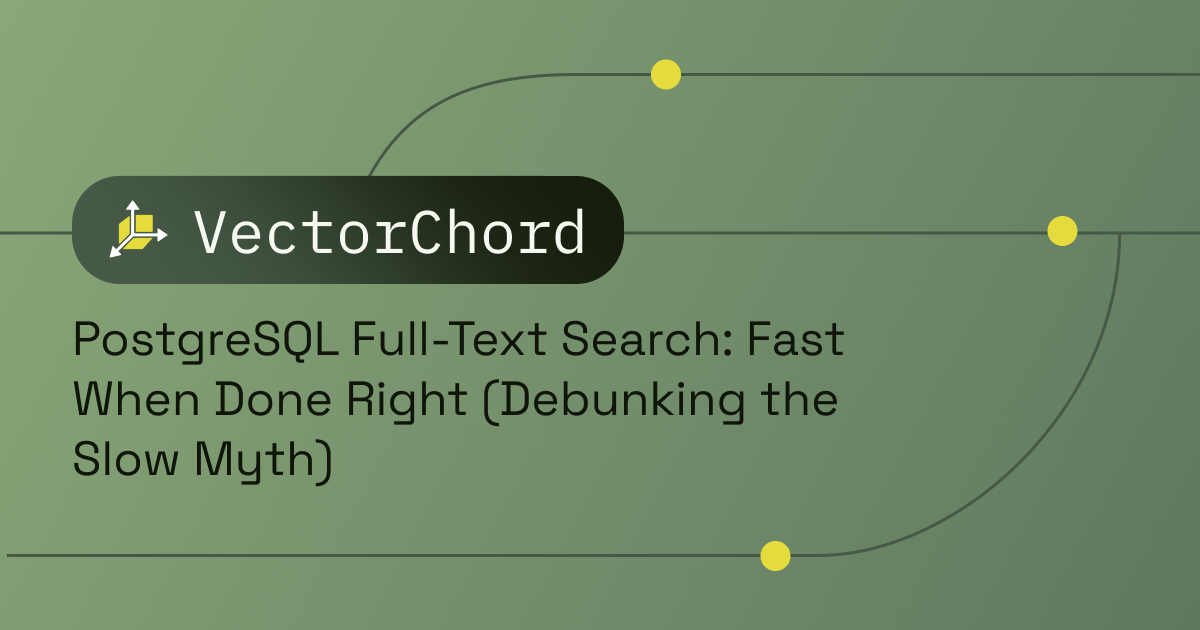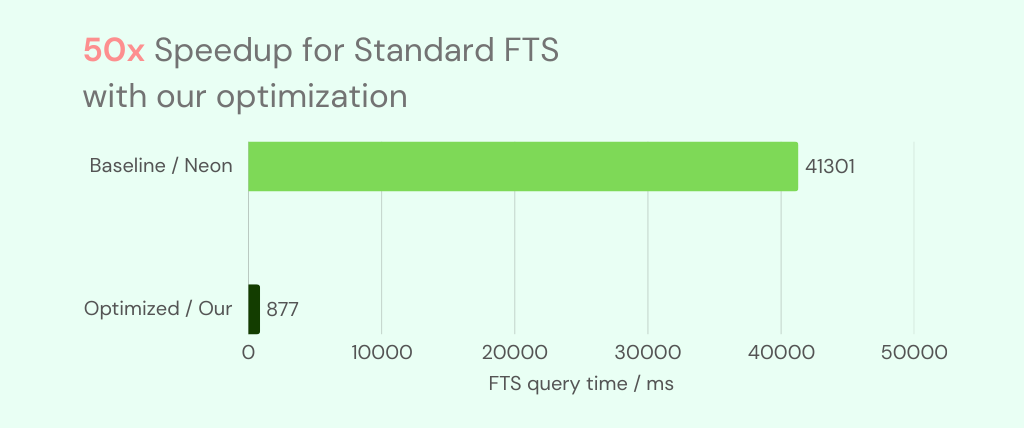PostgreSQL Full-Text Search: Fast When Done Right (Debunking the Slow Myth)
 Jinjing Zhou
Jinjing Zhou
You might have come across discussions or blog posts suggesting that PostgreSQL's built-in full-text search (FTS) struggles with performance compared to dedicated search engines or specialized extensions. A notable recent example comes from Neon's blog post, "Performance Benchmark: pg_search on Neon" (link).
In their benchmark, Neon compared query performance on their database platform with their pg_search extension (based on Rust's Tantivy library via pgrx) against the Postgres built-in fulltext search setting with tsvector and GIN index. They commendably stated they optimized this standard setup by adding GIN indexes where appropriate (benchmark code available here).
However, while adding GIN indexes is a necessary first step, their results showing significantly slower performance for the "standard" setup suggest crucial additional optimization steps for PostgreSQL FTS were likely missed. The conclusion that standard FTS is inherently much slower than pg_search might be based on an unintentionally handicapped baseline.
Let's dive into how to correctly set up and use standard PostgreSQL FTS for optimal performance, addressing the specific configuration flaws likely present in the baseline used in the Neon benchmark, and demonstrating the true speed of built-in FTS. We'll show concrete numbers demonstrating a ~50x performance increase just by applying these standard optimizations to the baseline configuration.
The Benchmark Setup (Recap from Neon's Analysis)
The analysis used a table structure similar to this with 10 million log entries:
CREATE TABLE benchmark_logs (
id SERIAL PRIMARY KEY,
message TEXT,
country VARCHAR(255),
severity INTEGER,
timestamp TIMESTAMP,
metadata JSONB
);
They tested various query types. Many involved searching the message text field, using queries structured like this in their "standard Postgres" examples:
-- Create index on to_tsvector('english', message)
CREATE INDEX message_gin ON benchmark_logs USING gin (to_tsvector('english', message));
-- Example problematic query structure (likely used in Neon's baseline)
SELECT country, COUNT(*)
FROM benchmark_logs
WHERE to_tsvector('english', message) @@ to_tsquery('english', 'research')
GROUP BY country
ORDER BY country;
Even with a GIN index present on message, this query structure and the likely default GIN index settings are where the performance issues for the standard FTS baseline begin.
Our Test Environment Details (Replicating the Baseline Scenario)
To demonstrate the impact of proper optimization on standard FTS, we used the following setup:
Instance: AWS EC2
i7ie.xlargewith local NVMe SSD (minimizing I/O impact).CPU: 4 vCPUs.
PostgreSQL Configuration: PostgreSQL 16 via Docker, configured for the hardware:
docker run -d \ --name my-postgres \ --network=host \ -v /mnt/localssd/pgdata:/var/lib/postgresql/data \ -e POSTGRES_PASSWORD=mysecretpassword \ postgres:latest \ -c shared_buffers=8GB \ -c maintenance_work_mem=8GB \ -c max_parallel_workers=4 \ -c max_worker_processes=4Parallelism Note: This setup provides
max_parallel_workers_per_gather = 2. The Neon post mentioned their test environment used 8 parallel workers due to larger instances, implying potentially higher parallelism (max_parallel_workers_per_gatherup to 8) than our setup. Our optimized results for standard FTS were achieved with less query parallelism.
Mistake #1: Calculating tsvector On-the-Fly (Major issue)
The sample queries shown in the Neon blog (and common in basic FTS examples) calculate the tsvector within the WHERE clause:
WHERE to_tsvector('english', message) @@ to_tsquery('english', 'research')
This forces PostgreSQL to:
Perform Expensive Computation: Run
to_tsvector()(parsing, stemming, etc.) repeatedly for many rows during query execution.Limit Index Efficiency: Prevent the most direct and efficient use of the GIN index, even if one exists on the base
messagecolumn.
The Fix (For a Proper Standard FTS Baseline): Pre-calculate and store the tsvector.
Add a
tsvectorcolumn:ALTER TABLE benchmark_logs ADD COLUMN message_tsvector tsvector;Populate the column:
UPDATE benchmark_logs SET message_tsvector = to_tsvector('english', message);Index the
tsvectorcolumn (withfastupdate=off): (As shown in Fix #1)Rewrite queries:
-- Optimized standard FTS query SELECT country, COUNT(*) FROM benchmark_logs WHERE message_tsvector @@ to_tsquery('english', 'research') -- Use the indexed column! GROUP BY country ORDER BY country;
Mistake #2 : Ignoring GIN Index fastupdate (Minor issue)
While Neon's benchmark correctly identified GIN as the index type for standard FTS, it likely used the default setting: fastupdate=on.
fastupdate=on(Default): Prioritizes index update speed by using pending lists. This significantly slows down searches over time, especially on large, static datasets used for benchmarks, as both the main index and growing pending lists must be scanned. It also contributes to index bloat and less efficient page structure.fastupdate=off: Prioritizes search speed. Index updates are slower, but the resulting index is more compact and significantly faster to query as there are no pending lists to scan. Essential for read-heavy workloads or benchmarking search performance.
For a fair comparison focused on search speed, the standard FTS baseline should have used fastupdate=off.
The Fix (For a Proper Standard FTS Baseline):
-- Create the GIN index correctly for search speed
CREATE INDEX idx_gin_logs_message_tsvector
ON benchmark_logs USING GIN (message_tsvector) -- Index the dedicated tsvector column
WITH (fastupdate = off);
The Performance Impact: A ~50x Speedup for Standard FTS

What happens when we apply these standard optimizations to the standard PostgreSQL FTS setup? We tested a query in Neon's examples on the 10-million-row dataset:
Unoptimized Standard FTS (Neon's Baseline): ~41301 ms (41.3 seconds)
Optimized Standard FTS (Our Fixes): ~877 ms (0.88 seconds)
This demonstrates a ~50x speed improvement for standard PostgreSQL FTS achieved simply by applying well-established best practices. This transforms the baseline performance dramatically, suggesting the comparison point used in the Neon benchmark may not have represented the true potential of built-in FTS. This speedup was achieved even with potentially less query parallelism available than in Neon's tests.
The Grain of Truth: Ranking (ts_rank) Performance
Neon's analysis did likely highlight a valid point regarding ranking speed. Functions like ts_rank or ts_rank_cd can be relatively slow in standard PostgreSQL compared to just finding matches. This is because ranking requires fetching and processing data for all matching rows before limiting, which can be I/O and CPU intensive.
Beyond Standard FTS: Advanced Ranking with VectorChord-BM25
While standard FTS excels at finding matches quickly, if sophisticated, high-performance ranking is critical, specialized tools are often required. Instead of relying solely on built-in functions, consider VectorChord-BM25.
VectorChord-BM25 is a PostgreSQL extension specifically designed for fast, relevance-based ranking using the well-regarded BM25 algorithm. BM25 goes beyond simple term matching, estimating relevance based on term frequency within a document and inverse document frequency across the entire collection.

Key advantages reported for VectorChord-BM25 include:
High Performance: Designed for speed, reportedly outperforming other solutions like Elasticsearch (up to 3x faster) and potentially pg_search for ranking tasks.
BM25 Algorithm: Implements a standard, effective relevance ranking model.
Specialized Indexing: Uses a dedicated bm25 index type (leveraging optimizations like Block WeakAnd) which is crucial for both performance and calculating the global statistics needed for BM25 scoring.
Dedicated Data Type: Introduces a bm25vector type to store tokenized representations suitable for BM25.
If your application heavily relies on the quality and speed of relevance ranking, and standard ts_rank proves insufficient, VectorChord-BM25 presents a powerful, integrated alternative within PostgreSQL.
Conclusion: Standard FTS is Faster Than You Might Think
Standard PostgreSQL FTS is a highly capable and performant feature for finding documents when correctly optimized using tsvector columns and properly configured GIN indexes (with fastupdate=off for reads). Benchmarks suggesting otherwise may be comparing against unoptimized baselines.
For advanced relevance ranking where standard ts_rank falls short, specialized extensions like VectorChord-BM25 offer significant performance improvements by implementing algorithms like BM25 with dedicated data types and optimized indexing strategies.
Choose the right tool for the job: optimize standard FTS first, and if high-performance relevance ranking is paramount, explore dedicated extensions built for that purpose.
Subscribe to my newsletter
Read articles from Jinjing Zhou directly inside your inbox. Subscribe to the newsletter, and don't miss out.
Written by